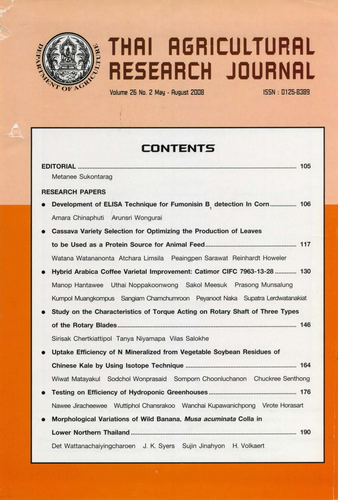Uptake Efficiency of N Mineralized from Vegetabel Soybean Residues of chinese Kale by Using Isotope Technique
DOI:
https://doi.org/10.14456/thaidoa-agres.2008.14Keywords:
vegetable soybean, lsotope technique, N-mineraliztion, Chinese KaleAbstract
Tne objective of this research was aimed to evaluate availability of mineralized N from vegetable soybean veriety no 75 for chinese kale growth by using 15N technique. The experiment was conducted in RCB design with 3 replications and 4 treatments namely vegetable soybean variety No 75 was grown with variation of nitrogen fertilizer. Nitrogen fertilizer was applied at the rate of 0, 16, 32 and 48 kg/rai. A micro-plot of 25x50 cm within 1.2x6 m plot size was surrounded with zinc flame for application of isotope N fertilizer using 15N urea (5% atom excess). growth, yield and N2 -fixing efficiency of soybean wee determined after 65 days of growing. soybean plant residues were incorporated into the soil after harvest. The Chinese kale plantlets were transplanted after soil incubation for 21 days. Increasing of N-fertilizer resulted in increasing soybean plant weight and yield. The maximum plant weight and yield were found in 32 kg/rai of N fertilizer treatment. Although higher growth and yield of soybean high N application but the formation of root nodules were applied at the rate of 32 and 48 kg/rai and the efficiency of nitrogen fixation was also reduced. The incorporation of soybean plant residues at 2.0, 2.3 and 2.4 t/rai caused in mineralization of inorganic N totally before transplanting a t 22.63, 32.95 and 26.2 kg/rai, respectively. This amount of mineralized N was uptaken by Chinese kale as the consequent crop at approximately of 21-34 % leading to increase in the fresh weight yield of 20-35 % at 56 days after transplanting
Downloads
Published
How to Cite
Issue
Section
License
Copyright (c) 2017 วารสารวิชาการเกษตร (Thai Agricultural Research Journal)

This work is licensed under a Creative Commons Attribution-NonCommercial-NoDerivatives 4.0 International License.
Thai Agricultural Research Journal



